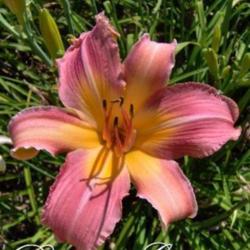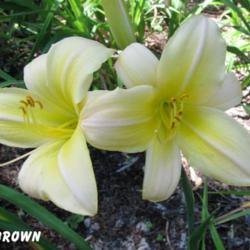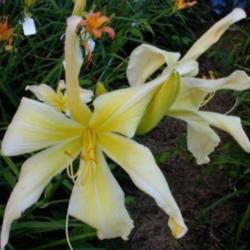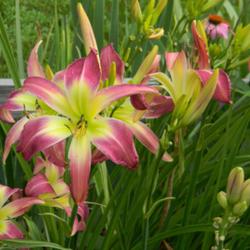What a wonderful history of your Uncle's daylilies, and your time together. Forgive me for mentioning it, but you might already technically be a hybridizer if they bloomed the first time in your garden, and if it's also true that this is the point at which someone becomes the originator of a particular cultivar (whether they dabbed the pollen or not, and BTW, just one dab can easily result in dozens of DL seeds). If so, he gave you a time-capsule daylily gift that could forever be a common thread between him, you, and future generations. You could even register one of them named in some way to honor him by simply getting permission from family members to register on his behalf. If not, they still endure by simply beginning and ending with you just enjoying them in your garden, and I respect that you may not want to do anything more with them than that. Your incredible donation of effort and time on behalf of ATPs community is its own kind of legacy.

So, I do hope that people see how much is brought forth by *all* daylily gardeners, whether they are long-time club members, professionals, hybridizers or not, decades into the community or just got their first daylily fan. It only adds to everyone's benefit when new vistas are opened. Veterans, authorities, and daylily organizations around the world (of few or many years tenure) still find new things to share that have not been encountered before, even if brought forth from gardeners who notice something unique happening with colors, or end up with dozens of unexpectedly viable seeds, who share a story that encourages others to express their love through daylilies, or who take some new approach for setting goals or trying new ways to do things, whether for color/patterns, performance, or a balance of bloom and scape. Each contribution builds part of the path that keepsakes daylily history, the vitality of current communities, and the future of the these cultivars that we shepherd forward by tending in our gardens.
Even if it may sometimes seem uncomfortable if new information comes forth from new eyes, the love of daylilies naturally helps to create a welcoming community that honors everyone's efforts and contributions, and supports exploration and sharing of new information - there is so little cost, and so little to be lost, by encouraging that further. Each bit multiplies the value of the whole. I, too, feel surrounded by many winners who venture forth unattributed to mention or do something new, even if it results in being received with great skepticism, and who document what is seen and tried in their own gardens, whether by old-time hands or new, and hold steadfast in the their appreciation for this amazing flowering plant that connects us all. Anyone who reads an article or hunts up a post, shares a photo or uploads and checks daylilly info, or helps to keep a social group forming or growing around the encyclopedic information contributed specifically from "everyone and anyone" is in the deepest sense a researcher, and thank goodness for that being the case at ATP.
My own goals for daylily hybridizing are a build-on in part from a decade of purebred canine field trials, health testing, and three research-focused litters to explore new practices in a breed that was near to imploding from inbreeding depression. I love those dogs, and that is what drove me to try new things on their behalf. Following that, those same goals were for a short time applied toward fuchsias, but imagine my chagrin when I learned they had already imploded a once vibrant gardening society, and right in my own new back yard. The level of difficulty in hybridizing fuchsia, and the micro-weather in my gardens, prevented me from doing much there. And so I came to the easy-care, easily dabbed and collected seeds of the simple but amazing daylily, with the same desire to seek a balance for best chances to ensure their future vitality and diversity. I will never sell a daylily. But just by growing, dabbing, or documenting we each increase their future prospects.
More specifically, my goal is to hybridize first and foremost toward cultivars that are (or are descended from) those that were tested for rust performance in AHS-supported university trials from roughly 2001-2007, including survey results from everyday growers that were collected for some time as well. In order to do that, I focus mostly on cultivars that have a pedigree that can be studied, and then also select mainly toward cultivars that have lineages considered to be somewhat resistant. Any resulting new cultivars that are worth documenting may be registered so the lineage can be recorded for posterity. And, I will try to test those cultivars to continue the effort to map any progress toward daylily resilience. Then, because of my climate and growing conditions, I am also leaning heavily toward evergreen or semi-evergreens, so that I can enjoy viewing beautiful daylily foliage year-round. I'm still adjusting goals about what I find most compelling in terms of scapes, bud counts, bloom season and duration, colors and other flower "accessories" but I seem to be narrowing down to purple, reds and saturated pinks, larger blooms (easier for old hands to work the dabbing on, and easier to see from afar), scapes that manage to hold at least a 90-degree angle or so when bloom-laden, and cultivars that are slow increasers. I'm not sure I'd ever want to limit my goals further down that that!

And I think that even those who do not dabble in dabbing have goals, too, and very important ones. By choosing or receiving a particular plant to enjoy in their garden, a person often invests money, time, other resources, learning, and tending to bring forth its gifts. We all observe and plan based on how they fare, what interests us or delights our eyes, and what we wish for them in the future (fragrance, new forms, interesting colors, and plants that stay easy to access and care for, for example). So ... perhaps one of you amazing moderators might be willing to split this discussion off (if having goals is not "odd"

) in order to invite everyone, old and new, to share their goals. Not limited to hybridizing, but open to whatever goals inspire them to tend to and share their experiences with daylilies?





